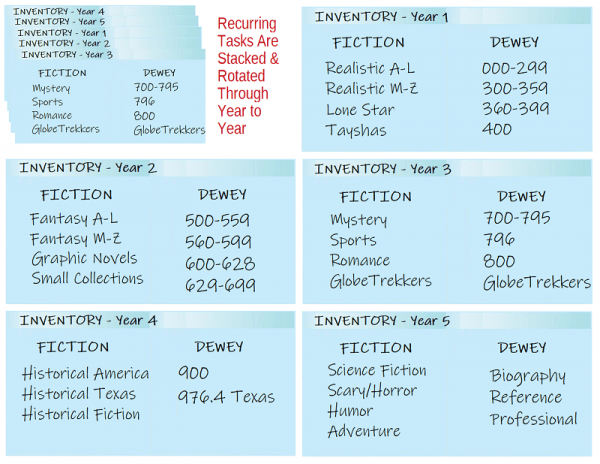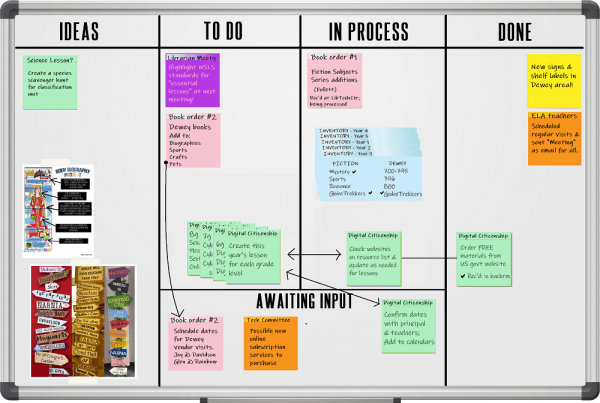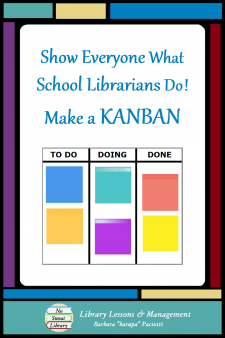 A recurring lament on School Librarian listservs & social media is that our education colleagues don’t really know what School Librarians do. Some teachers have even said to us, “It must be nice to spend all day reading books.” If only it were that easy!
A recurring lament on School Librarian listservs & social media is that our education colleagues don’t really know what School Librarians do. Some teachers have even said to us, “It must be nice to spend all day reading books.” If only it were that easy!
The amount of work we School Librarians expend to keep the school library functioning is daunting, not to mention keeping up with everyone’s curriculum and designing meaningful lessons for students. However, there’s a simple way to conquer misconceptions and reveal the enormity of school librarianship…
Hang a KANBAN!
Kanban is a visual process management system that allows us to plan projects, arrange priorities, keep track of progress, and manifest what has been accomplished. More importantly, Kanban is an eye-catching display that shows everyone—teachers, principals, visitors, students—just how busy we School Librarians really are!
THE ORIGINS OF KANBAN
Kanban, from the Japanese word for signboard, was developed by Taiichi Ohno, an industrial engineer at Toyota. Inspired by the “bin” system used in airplane factories in the United Kingdom during World War II, then later applied to shelf re-stocking in their supermarkets, Ohno adapted it as a method to implement “just-in-time” production that responds to consumer demand.
During the early 2000s, software development companies adapted the Kanban from a production system for manufacturing into a software development workflow to coordinate tasks in project teams. Since then it has morphed into systems for change management, marketing, human resources, knowledge work, and personal workflow.
The last—personal workflow—is why a Kanban is useful for School Librarians: the variety of tasks we do—from budgeting to collection development to facility management to creating lessons to professional development to school committees—can all be organized and tracked using a Kanban.
WHY USE A KANBAN?
 With so many print and digital organizers available, it may be tempting to use one of those for task organization—in fact, many School Librarians already do that. But I say DON’T—no one sees a print or digital organizer!
With so many print and digital organizers available, it may be tempting to use one of those for task organization—in fact, many School Librarians already do that. But I say DON’T—no one sees a print or digital organizer!
I do use print and digital checklists for myself during workdays at the start and end of the school year, but during the school year I use a Kanban whiteboard with colorful square sticky notes to display all my ongoing tasks and projects and how they are progressing.
That big whiteboard with its columns of bright-colored notes is pretty hard to miss. In addition to helping me stay focused, it prompts a lot of conversations with others, and conveys to them just how many things we School Librarians must do to make the school library a valuable learning space.
HOW TO CREATE A KANBAN
The simplest Kanban is a whiteboard divided into 3 columns and labeled TO DO, DOING, DONE. Each task is written down on a square sticky note and moved from column to column as the job progresses.
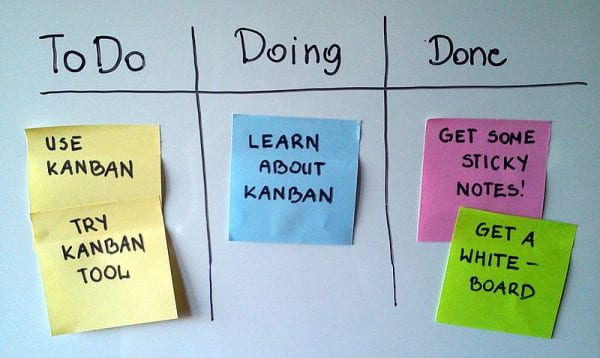
Lasovski, Jeff. commons.wikimedia.org/wiki/, 9 July 2022.
I recommend using at least a 24″ x 36″ whiteboard—remember, we’re planning for the entire school year, and it’s amazing how quickly the board fills up with tasks. Instead of drawing column lines with a whiteboard marker, use narrow black (or other color) tape in order to move notes around without smearing the grid.
I prefer to divide my whiteboard into 4 columns, adding an IDEAS column at the left to accumulate possible tasks or projects as they come to mind. I also use IN PROCESS instead of “Doing,” because I’m not always actively working on everything in that column. In addition, I merge the bottom of the two middle columns and label it AWAITING INPUT to indicate that other folks need to do or give me something in order to continue.
To make my Kanban really useful, I color-code the sticky notes for categories of related tasks. In this way I see where the bulk of the year’s work will be so I can prioritize tasks & projects for a smooth workflow. Here are the colors and categories I use:
EFFECTIVE KANBAN STRATEGIES
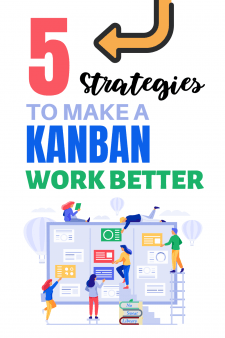 A Kanban makes it easy to prioritize activities. I put my most immediate or most important tasks at the top and less needful ones lower down. If timing becomes more critical for something, I just move the sticky note upward.
A Kanban makes it easy to prioritize activities. I put my most immediate or most important tasks at the top and less needful ones lower down. If timing becomes more critical for something, I just move the sticky note upward.
For large projects with several phases, I use a sticky note for each phase (with project title along the top) and stack them in consecutive order. As each piece of the project begins & progresses, I move notes to the appropriate column, stacking as needed, usually in a single row across the board, and slightly separated from disparate tasks.
One advantage of the whiteboard is being able to use a dry erase marker to draw arrows or symbols next to a sticky note, which is very helpful to align phases of a project. Plus, so much of what we do in the school library is interrelated, so if I have to work on something else before I can go ahead with a task, I can line-link the notes together without moving them.
Certain of our school librarian chores recur from year to year, so we can reuse those notes. For example, I do mini-inventories of sections of the library over a 5-year period instead of one big inventory—it takes less time and is less disruptive to students and teachers. I use five 3”x5” rectangle sticky notes and list a column of Fiction Subjects and a column of Dewey numbers for each year. When I complete each section, I check-mark it. At the end of the school year I move the top note to the bottom of the stack and put the stack back in the TO DO column, ready for the next school year’s mini-inventories.
When a task or project is finished, it’s tempting to throw away the note, but don’t do that! I accumulate them near the top of the DONE column until the end of the grading period so I am sure to include finished tasks in my Report to Principal. Then I move them as a batch toward the bottom of the Done column. There’s great satisfaction in watching the sticky notes build up toward the top in that last column, seeing how much I’ve accomplished throughout the school year!
KANBAN IS A SPECTACULAR ADVOCACY TOOL!
It’s important to hang the Kanban in a prominent place where it’s easy to keep updated, and also where it can be seen by others. I hang mine on the back wall of my librarian office, where anyone at the circulation counter could see the colorful display through the windows. Many students and teachers ask about my Kanban, which gives me an opportunity to talk about how the school library can assist them.
At the end of the school year, I take a snapshot of the Kanban with all the finished tasks, then paste it into the final Report to Principal and include it in my professional evaluation report to visually emphasize how busy my year has been!
So, go to it! Create your own KANBAN!



